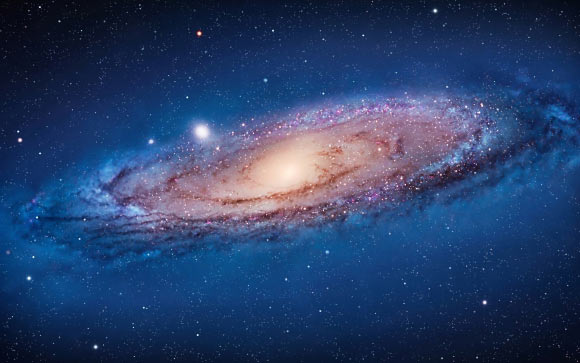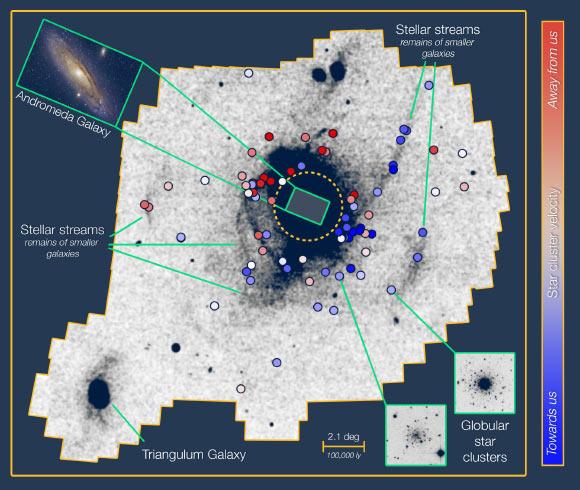An analysis of data from the Pan-Andromeda Archaeological Survey (PAndAS) has uncovered two major episodes of accretion, probably separated by billions of years, in which the Andromeda galaxy, a neighbor to our Milky Way Galaxy, gobbled up several small galaxies.

The Andromeda galaxy, also known as Messier 31 or M31, is located about 2.4 million light-years away from Earth in the constellation of Andromeda. It is the largest galaxy in the Local Group, which also contains our own Milky Way Galaxy and more than 50 other galaxies. Image credit: NASA.
Large galaxies like the one we live in are believed to grow through repeated merging with dwarf galaxies.
Gas and dwarf galaxies in the vast cosmic web follow the gravitational paths laid out by dark matter-traversing filaments, they migrate slowly toward collections of dark matter and assemble into large galaxies.
As dwarf galaxies are pulled in by gravity, they are also pulled apart, leaving behind long trailing streams of stars and compact star clusters.
Australian National University astronomer Dougal Mackey and colleagues found evidence for two major migration events in the history of Andromeda: the more recent migration event occurred a few billion years ago and the older event some 10 billions years ago.
The evidence comes from ‘galactic archaeology,’ the use of the motions and properties of stars and stellar clusters to reconstruct the formation and evolutionary history of galaxies.
“The Milky Way is on a collision course with Andromeda in about 4 billion years,” Dr. Mackey said.
“So knowing what kind of a monster our Galaxy is up against is useful in finding out the Milky Way’s ultimate fate.”
Dr. Mackey and co-authors analyzed the motions and properties of 77 globular clusters and several larger stellar substructures in the halo of Andromeda. This allowed them to recreate the way the galaxy drew smaller galaxies in.
“By tracing the faint remains of these smaller galaxies with embedded star clusters, we’ve been able to recreate the way Andromeda drew them in and ultimately enveloped them at the different times,” Dr. Mackey said.
“Seeing two distinct meal times for Andromeda was quite surprising,” said University of Surrey astronomer Michelle Collins.
“The way the globular clusters move around Andromeda suggest that this galaxy had a large breakfast around 10 billion years ago, and a big lunch perhaps only a few billion years ago.”

The globular clusters studied (lower right insets), indicated by colored circles, are located in the outer halo of the Andromeda galaxy, beyond the bright disk of the galaxy (upper left inset). The star clusters separate into two groups — those associated and unassociated with stellar streams — that have very different orbits, a result that points to two discrete migration events in the history of the galaxy. The color of each circle indicates the line-of-sight velocity of the corresponding star cluster. Image credit: Australian National University / NSF’s National Optical-Infrared Astronomy Research Laboratory.
The discovery presents several new mysteries, with the two bouts of galactic feeding coming from completely different directions.
“The two accretion events have come from strikingly different directions, as the two globular cluster populations are orbiting at right angles to one another,” Dr. Collins said.
“This directionality may tell us something about the cosmic web within which Andromeda and the Milky Way are embedded, and gives us insight into the formation of our massive neighbor.”
“This is very weird and suggests that the extragalactic meals are fed from what’s known as the cosmic web of matter that threads the Universe,” said Professor Geraint Lewis, from the Sydney Institute for Astronomy at the University of Sydney.
“More surprising is the discovery that the direction of the ancient feeding is the same as the bizarre ‘plane of satellites,’ an unexpected alignment of dwarf galaxies orbiting Andromeda.”
The findings were published in the October 3, 2019 issue of the journal Nature.
_____
Dougal Mackey et al. 2019. Two major accretion epochs in M31 from two distinct populations of globular clusters. Nature 574: 69-71; doi: 10.1038/s41586-019-1597-1







